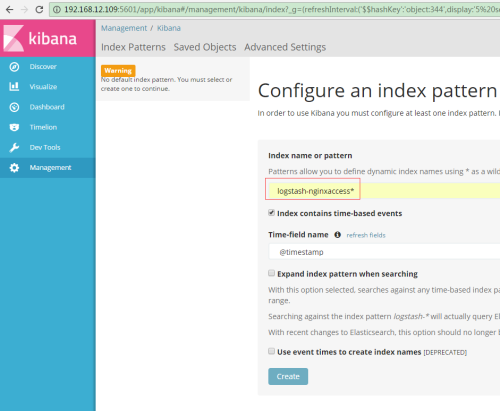filebeat+kafka+ELK5.4安装与部署
本文共 4734 字,大约阅读时间需要 15 分钟。
用ELK打造强大的日志分析平台,具体拓扑结构如下:
在这里我们将进行kafka+filebeat+ELK5.4的部署
各软件版本
| 1 2 3 4 5 6 | jdk-8u131-linux-i586. tar .gz filebeat-5.4.0-linux-x86_64. tar .gz elasticsearch-5.4.0. tar .gz kibana-5.4.0-linux-x86_64. tar .gz logstash-5.4.0. tar .gz kafka_2.11-0.10.0.0.tgz |
1、JDK安装配置(略过)
2、ELK安装与配置
| 1 2 3 4 5 6 7 8 9 10 11 12 13 14 15 16 17 18 19 20 21 22 23 24 25 26 27 28 29 30 31 32 33 34 35 36 37 38 39 40 41 42 43 44 45 46 47 48 49 50 | 创建ELK用户,并进行文件解压 1.elasticsearch配置 [elk@localhost elasticsearch-5.4.0]$ vi config /elasticsearch .yml ..... network.host: 192.168.12.109 # # Set a custom port for HTTP: # http.port: 9200 .......... 保存,启动 [elk@localhost elasticsearch-5.4.0]$ nohup bin /elasticsearch & 验证 # [elk@localhost elasticsearch-5.4.0]$ curl http: //192 .168.12.109:9200 { "name" : "aCA2ApK" , "cluster_name" : "elasticsearch" , "cluster_uuid" : "Ea4_9kXZSaeDL1fYt4lUUQ" , "version" : { "number" : "5.4.0" , "build_hash" : "780f8c4" , "build_date" : "2017-04-28T17:43:27.229Z" , "build_snapshot" : false , "lucene_version" : "6.5.0" }, "tagline" : "You Know, for Search" } 2、kibana安装与配置 [elk@localhost kibana-5.4.0-linux-x86_64]$ vi config /kibana .yml ## Kibana is served by a back end server. This setting specifies the port to use. server.port: 5601 # Specifies the address to which the Kibana server will bind. IP addresses and host names are both valid values. # The default is 'localhost', which usually means remote machines will not be able to connect. # To allow connections from remote users, set this parameter to a non-loopback address. server.host: "192.168.12.109" .......... # The URL of the Elasticsearch instance to use for all your queries. elasticsearch.url: "http://192.168.12.109:9200" .......... [elk@localhost kibana-5.4.0-linux-x86_64]$ nohup bin /kibana & 在浏览器访问 能访问即可 |
3、kafka安装与配置
这里我们只做单机192.168.12.105部署单节点
4、logstah安装与配置
| 1 2 3 4 5 6 7 8 9 10 11 12 13 14 15 16 17 18 19 20 21 22 23 24 25 26 27 28 29 30 31 32 33 34 35 36 37 38 39 40 41 42 43 44 45 46 47 48 49 50 51 52 53 54 55 56 57 58 59 60 | [elk@localhost logstash-5.4.0]$ vi nginx.conf 这里新生成一个配置文件 input { kafka { codec => "json" topics_pattern => "logstash-.*" bootstrap_servers => "192.168.12.105:9092" auto_offset_reset => "latest" group_id => "logstash-g1" } } filter { if "nginx-accesslog" in [tags] { grok { match => { "message" => "%{IPORHOST:http_host} %{IPORHOST:clientip} - %{USERNAME:remote_user} \[%{HTTPDATE:timestamp}\] \"(?:%{WORD:http_verb} %{NOTSPACE:http_request}(?: HTTP/%{NUMBER:http_version})?|%{DATA:raw_http_request})\" %{NUMBER:response} (?:%{NUMBER:bytes_read}|-) %{QS:referrer} %{QS:agent} %{QS:xforwardedfor} %{NUMBER:request_time:float} %{GREEDYDATA:traceID}" } } mutate { convert => [ "status" , "integer" ] convert => [ "body_bytes_sent" , "integer" ] convert => [ "request_time" , "float" ] } geoip { source => "remote_addr" } date { match => [ "timestamp" , "dd/MMM/YYYY:HH:mm:ss Z" ] } useragent { source => "http_user_agent" } } if "tomcat-accesslog" in [tags] { grok { match => { "message" => "%{IPORHOST:clientip} \[%{HTTPDATE:timestamp}\] \"(?:%{WORD:http_verb} %{NOTSPACE:http_request}(?: HTTP/%{NUMBER:http_version})?|%{DATA:raw_http_request})\" %{NUMBER:response} (?:%{NUMBER:bytes_read}|-) %{QS:referrer} %{NUMBER:request_time:float} %{GREEDYDATA:traceID}" } } date { match => [ "timestamp" , "dd/MMM/YYYY:HH:mm:ss Z" ] } } } output { elasticsearch { hosts => [ "192.168.12.109:9200" ] index => "logstash-%{type}-%{+YYYY.MM.dd}" document_type => "%{type}" } #stdout { codec => rubydebug } } 保存,并启动 [elk@localhost logstash-5.4.0]$ nohup bin /logstash -f nginx.conf & |
5、filebeat安装与配置
将filebeat分别拷贝到需要采集的服务器,进行解压,在这里我们分别采集Nginx,tomcat日志
Nginx服务器
| 1 2 3 4 5 6 7 8 9 10 11 12 13 14 15 | [user@localhost filebeat-5.4.0-linux-x86_64]$ vi filebeat.yml filebeat.prospectors: - input_type: log paths: - /data/programs/nginx/logs/access .log tags: [ "nginx-accesslog" ] document_type: nginxaccess tags: [ "nginx-test-194" ] output.kafka: enabled: true hosts: [ "192.168.12.105:9092" ] topic: logstash-%{[ type ]} [user@localhost filebeat-5.4.0-linux-x86_64]$ nohup filebeat -c filebeat.yml & |
tomcat服务器
| 1 2 3 4 5 6 7 8 9 10 11 12 13 14 15 | [user@localhost filebeat-5.4.0-linux-x86_64]$ vi filebeat.yml filebeat.yml filebeat.prospectors: - input_type: log paths: - /data/tomcat/logs/localhost_access_log * tags: [ "tomcat-accesslog" ] document_type: tomcataccess tags: [ "tomcat103" ] output.kafka: enabled: true hosts: [ "192.168.12.105:9092" ] topic: logstash-%{[ type ]} [user@localhost filebeat-5.4.0-linux-x86_64]$ nohup filebeat -c filebeat.yml & |
完成以上,我们的平台就搭建好了,接下来我们创建索引
输入:logstash-nginxaccess*

输入logstash-tomcataccess*
数据通过filebeat到kafka、ELK成功展示出来
来张炫图
本文转自 jackjiaxiong 51CTO博客,原文链接:http://blog.51cto.com/xiangcun168/1933509
转载地址:http://jzsxa.baihongyu.com/
你可能感兴趣的文章
BOM:文档对象模型 --树模型
查看>>
我的Android进阶之旅------>WindowManager.LayoutParams介绍
查看>>
segment
查看>>
获取鼠标的原始移动值
查看>>
Linux信号 编程
查看>>
有关滚动与位置
查看>>
Box2D自定义重力
查看>>
chpasswd
查看>>
mysqldump --single-transaction 和--lock-tables参数详解
查看>>
android 数据库_sql语句总结
查看>>
python购物车
查看>>
解决python2和python3的pip冲突
查看>>
面试/编程
查看>>
linux每日命令(16):head命令
查看>>
公司内部分享【富有成效的每日站会】总结
查看>>
打造一个上传图片到图床利器的插件(Mac版 开源)
查看>>
iOS横竖屏
查看>>
thinkphp判断更新是否成功
查看>>
Do While ... Loop 与 Do Until ... Loop 的区别
查看>>
【Linux】查询某个字符串出现次数
查看>>